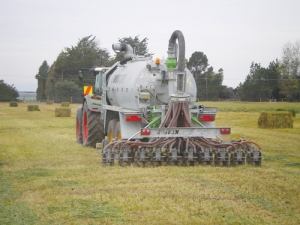$52,500 fine for effluent mismanagement
A Taupiri farming company has been convicted and fined $52,500 in the Hamilton District Court for the unlawful discharge of dairy effluent into the environment.
 Injecting dairy effluent directly into soil has been found as the most efficient way of applying, with the least N losses.
Injecting dairy effluent directly into soil has been found as the most efficient way of applying, with the least N losses.
New Zealand's farmers seem to have at last woken up and smelt the coffee.
They're realising that farmyard manure and dairy effluent have exceptional fertiliser value, and used wisely can greatly reduce inputs.
Many set-ups, particularly in the dairy sector, are being forced to meet increasingly tough environmental standards applied by local authorities; they are rightly concerned about runoff, groundwater contamination and destruction of local habitat.
Most 'new builds' must have a storage system to hold the effluent produced, particularly in wet seasons, and where ground conditions do not lend themselves to heavy traffic.
Unfortunately, the traditional method of application, centred on 'put it on thick lads, she'll be right' can result in two-thirds of the available N value being lost as ammonia emissions, losing the best part of the fertiliser value.
So it might pay to follow a lead from Europe: trials set up by the European Commission in 2013 looked at alternative methods of application and explored the best ways to reduce ammonia emissions.
These trials identified basically four ways to apply dairy liquid manures or slurries: the 'slap it on method', which resulted in losses of available N of up to 70%; application by dribble hose or trailing shoe applicators (losses 40% and 30% respectively); and shallow injection down to about 100mm (losses only 10%).
The findings mirror those in the Netherlands, which in the 1990s imposed mandatory injection for grassland. The results: ammonia emissions fell from 220 million kg in 1992 to 70 million by 1996 and 40 million kg by 2013.
So that foul smelling deposit excreted by Old Daisy – more often than not in the dairy shed when you're not looking – has serious potential to reduce input costs in these troubled dairy times. Stored properly and used wisely, with decent soil sampling en route, should help keep some businesses in the black.
For more than 50 years, Waireka Research Station at New Plymouth has been a hub for globally important trials of fungicides, insecticides and herbicides, carried out on 16ha of orderly flat plots hedged for protection against the strong winds that sweep in from New Zealand’s west coast.
There's a special sort of energy at the East Coast Farming Expo, especially when it comes to youth.
OPINION: The latest reforms of local government should come as no surprise.
The avocado industry is facing an extremely challenging season with all parts of the supply chain, especially growers, being warned to prepare for any eventuality.
Rural recycling scheme Agrecovery is welcoming the Government's approval of regulations for a nationwide rural recycling scheme for agrichemicals and farm plastics.
Despite a late and unfavourable start, this year’s strawberry crop is expected to be bountiful for producer and consumer alike.

OPINION: Your old mate welcomes the proposed changes to local government but notes it drew responses that ranged from the reasonable…
OPINION: A press release from the oxygen thieves running the hot air symposium on climate change, known as COP30, grabbed your…